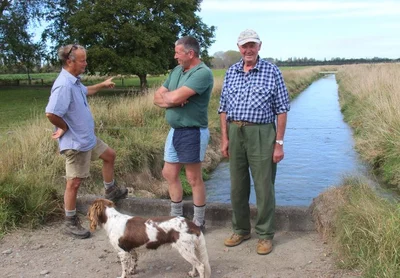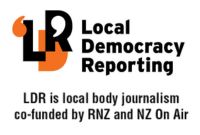Calls to review water rules to tackle dry creeks

Potential solutions to stop creeks from drying out and killing fish due to low water levels from the Ashburton River have been presented to Environment Canterbury.
Farmers and landowners pleaded for help from the regional council in March after Greenstreet Creek slowly dried up, causing the death of fish and eels.
At the time, farmers who saw the creek drying out couldn't get permission to divert water to stream until ECan used emergency powers to let them.
It was the solution they had always used until the new minimum flow restrictions came into effect last year, designed to keep more water in the Ashburton/Hakatere River.
In a meeting last week, Hekeao/Hinds Water Enhancement Trust executive director Dr Brett Painter presented some potential solutions to the Ashburton Water Zone Committee.
The Trust runs water enhancement projects across the Hekeao/Hinds Plains, including New Zealand’s largest managed groundwater rehabilitation project.
Painter, a former environmental infrastructure project leader for Environment Canterbury for 11 years, suggested a raft of possible solutions and “shadow consents” for the Greenstreet area.
He looked at “piggybacking onto existing water distribution and storage infrastructure” and existing water take consents to provide flows to maintain aquatic life during dry periods.
He also noted the use of “compliance discretion for trials” – trialling solutions without the need for consents - being something that could be considered.
ECan director of science Dr Tim Davie said the fundamental issue is consents can’t be granted that go against the minimum flows.
“We are still bound by minimum flows set out in the plan.”
ECan zone manager Jennifer Rochford acknowledged Painter’s suggestions were exactly the conversations the regional council wanted to have but she was concerned about rushing into an engineering solution based on a dry summer.
“We are not putting anything off the table.”
There are other options to consider to prepare for if the river goes dry and an expensive engineering solution may not be required in normal circumstances, she said.
“This is really a decision for the community as the cost will be borne there.”
The Zone Committee will be urging ECan to look at the options presented at their meeting last week to continue the conversation.
Greenstreet farmer Darryl Butterick also presented a letter from the friends of Greenstreet Creek asking to work alongside ECan on a long-term solution.
“No one wishes to see the creek run dry again.
“We seek to work alongside ECan to establish a sustainable and workable process whereby the creek can be kept alive as well as keeping the appropriate flows in the Ashburton River and O’Shea’s Creek.”
They requested a working group be formed to monitor Greenstreet waterways and take appropriate action as soon as required.
River review required
Solutions to the minimum flow impacts are on the table but a review of the changes implemented last year is not.
Ashburton Water Zone Committee members still believe a review of the minimum flows on the Ashburton River is necessary but ECan do not have any plans to go near it until 2028.
The committee asked ECan in February for an update on the implementation and impacts of the minimum flows that were introduced at the start of July.
In response, it received a 35-point memo from ECan director of science Dr Tim Davie.
“To do a full assessment of the effectiveness of a plan is a big job”.
It’s not just throwing out a few stats, he said.
In the memo, he said the river was estimated to run above 6 cumecs for around four weeks longer than it would have had the new minimum flow restrictions not been in place.
“In terms of that simple statistics, the plan is achieving what it’s setting out to do, acknowledging there are consequences of that.”
Minimum flows for the Ashburton River were set in the Canterbury Land and Water Plan in 2018 and the subsequent consent review “was to bring consents in line” with the plans, he said.
Undertaking a review is not in ECan’s work programme at the moment, he said.
Zone chairperson Bill Thomas said a review was necessary because the issue was “more than irrigation”, with the ecological and social aspects to consider as well.
Committee member Chris Allen also felt a review is necessary now.
“It’s such a rigid plan that all the good stuff that was going on has been swept aside.”
He feels the economic aspects have been “lost in the whole process”.
“Consents have been degraded to negligible, they are actually worthless because there has been no water available for a significant part of the year.”
Allen challenged that flows are measured in litres per second with no consideration of water depth.
He was also conscious of the increase in the minimum flow from 6 cumecs to 10 cumecs in 2033, and it impacted consents.
ECan councillor Ian Mackenzie echoed Allan’s concerns about the “derogation of existing rights”.
“Some people would argue that they have effectively lost the right to irrigate now.”
“By meeting the 6 cumecs there is a whole lot of derogation going on already, and going to 10 cumec minimum flow is going to create even worse problems, so is that enough justification for a review of the plan?”
Acknowledging the impact of 6 cumecs, and that moving to 10 is a substantial rise again, “it would be reasonable to say that needs looked at again in terms of the overall outcomes”, Davie said.
There is time for it to be looked at again, and that could be as part of a review of the Land and Water Plan, including the flow and allocation limits, in 2028, Davie said.
By Jonathan Leask

